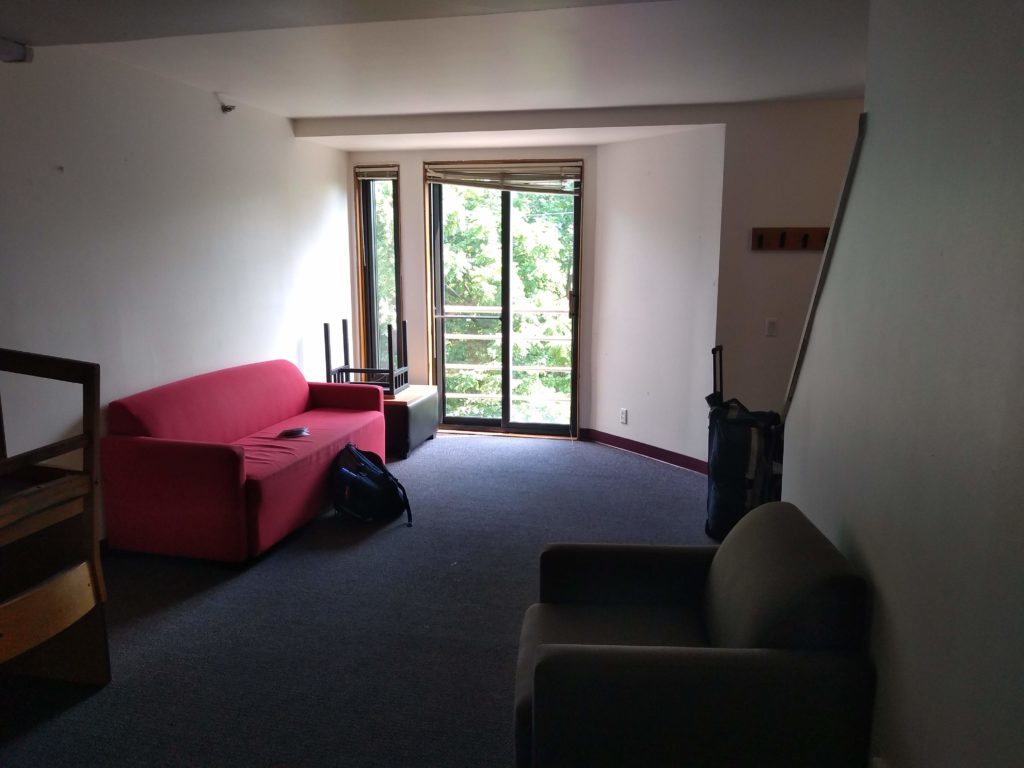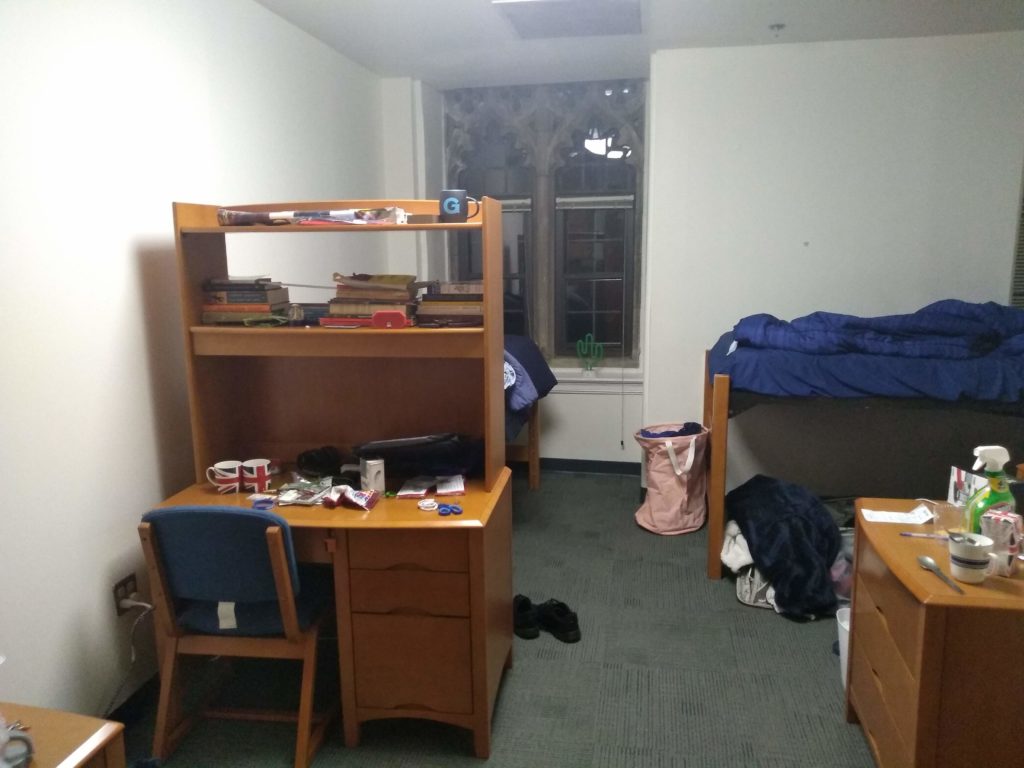Georgetown Dorms: What They’re Like From a Current Student
Georgetown University is unique in that its namesake describes its location. Georgetown is both a self-contained campus town and an interconnected part of the Georgetown neighborhood in southwest Washington, DC. Despite being a fairly small private school with 7,513 undergraduate students, its dorm offerings are diverse and quite nice ─ at least for upperclassmen! My name is Alex, and I have experienced the best and the worst of Georgetown dorms as a student in the College Class of 2021. I am a History major with minors in French and Russian, and I have tried to take in as much of Georgetown as possible. Here is what I have discovered about its dorms. A Hoya’s housing options at Georgetown differ depending on what class they are in. Freshmen are required to live on-campus and have a choice between four freshmen-only residences. Sophomores are allowed to live in more residences both on and off-campus, though some dorms are not available to them. All of Georgetown’s housing options are on the table for juniors and seniors. Because undergraduates are guaranteed on-campus dorms for their first three years, in addition to the fact that there is not too much off-campus housing to go around, the majority of them live on-campus. Seniors are the group that most often lives off-campus, with townhouses being their go-to option. Though townhouses and other off-campus living arrangements are categorized as “off-campus,” they are all a few blocks away from the main campus because they are located in the Georgetown neighborhood. The benefits of living off-campus include extra room, privacy, and a full kitchen. Price differences between residences are not based on where they are in relation to main campus, but rather what type of accommodations they offer. Residences are divided into two categories for pricing purchases ─ residence halls and apartments. Residence halls range from $4,377 to $4,662 per semester, while apartments cost between $4,662 to $4,789. Townhouses, which are in the apartment category, cost $5,338. Georgetown offers four types of living arrangements: residence halls, apartments, townhouses, and Living Learning Communities (LLCs). Residence halls include single, double, and triple rooms connected to a hall and a common room. Apartments have two stories, kitchens, full baths, and house four to nine roommates. Townhouses are essentially apartments, but are not connected to other units by a hall or stairwell. Many townhouses have small lawns as well. Lastly, LLCs are residence halls and apartments for students who share common interests or identities. You can learn more about the 14 LLCs that Georgetown offers. For students who are looking for the road less traveled when it comes to housing, there are two additional possibilities. The Capitol Applied Learning Labs (CALL) program gives students the one-semester opportunity to live in dorms near the US Capitol while they take program-specific classes and do an internship for credit. Upperclassmen can also rent their own apartments as far away from campus as they’d like, though this is uncommon. All dorms come with bunkable beds, desks with chairs, and closet space. Most have sinks, toilets, and showers included, while a few residence halls have communal bathrooms. Most residence halls have one single-gender floor with the rest being co-ed. Apartments come with a kitchen and refrigerator, and these are available in the common room in residence halls. Students wash their clothes in communal laundry rooms in all living spaces except for townhouses. Residence halls and some LLCs have one live-in Residential Assistant (RA) per floor, in addition to one Jesuit-in-Residence or Faculty-in-Residence. The Jesuits host social gatherings with food for their floor every week! I can neither confirm nor deny that a few dorms are connected to secret underground tunnels. Georgetown offers four dorms to freshmen: All of these dorms are residence halls which are mostly double rooms, with a limited number of singles and triples. VCW has private bathrooms with two sinks, one toilet, and one shower, while the rest of the halls have shared bathrooms and shower rooms. An added benefit of New South is that each room has its own sink. All of the rooms have a comfortable amount of space, too much closet space in fact in my experience! New South and VCW are close to each other and have convenient locations near the center of campus. Both are a one-minute walk away from Leo J. O’Donovan Dining Hall (Leo’s) and stone’s throw away from Lauinger Library and Healy Hall. For this reason as well as their private sinks and bathrooms, I would rank them in the top two in terms of freshman dorms. New South is slightly better in my opinion because it offers nice views of the Potomac River and campus. Harbin is a high-rise building located near the football field ─ further away from the center of campus ─ but has the added benefit of being closer to the Intercultural Center (ICC). This is important because many classes are taught in the ICC, especially for School of Foreign Service (SFS) students. Darnall, on the other hand, is at the end of campus, and +10-minute walks to class are the norm for Darnall residents. Their location does bring the benefit of being right next to Epicurean (Epi), Georgetown’s only eating establishment open 24/7. Students frequently go there to have a quesadilla at 2am after a night of social activities. Since Epi is a benefit meant for special occasions, I’ll award rank #3 to Harbin for its more convenient location and good views. The CALL program is one more option that is open to freshmen, at least after their first semester. Its rooms have the same amenities as VCW. The freshmen CALL alumni that I know have all lauded the program because it helped them gain maturity and a sharper career focus early on in college. The downside they mentioned was that CALL’s distance from the main campus put a pause on their social lives and extracurricular activities. It is definitely a program to consider, but with a lot of thought before committing! Students of all classes have the option of choosing roommates or opting in for the random selection process. Georgetown runs an internal platform called CHARMS to help incoming freshmen find roommates, though it is more common for Hoyas to search on their class Facebook group. Georgetown offers the following dwellings in addition to its freshman dorms: Arrupe and the townhouses are the best dorms “on the Hilltop” (at Georgetown) in my opinion. Arrupe has a clean, sleek, and modern design. Its common rooms offer spectacular views and its main lobby provides students with some of the comfiest study spaces on campus. The lobby also features the best community kitchen on campus and a conference room, both of which clubs frequently take advantage of. The rooms in Arrupe are spacious suites which house 2, 4, or 6 people. Each room includes a full bathroom and even a microfridge unit with a microwave! Townhouses offer independence while still being close to campus, which is why they are seen as the quintessential living arrangement for seniors. They are charming and quaint on the outside and are spacious on the inside. The two or three story layout often includes backyard patios and unfinished basements. Townhouses are fully furnished, and unlike main campus apartments they feature laundry rooms and dishwashers. Two Residential Ministers live near the townhouses and a Residential Living office is located in the neighborhood. Being perfect for legendary social gatherings, truly private study sessions, and those who seek a life untethered to Leo’s, townhouses have something for everyone. I would say that the dorms that have the least going for them are Vil A and VCE. Georgetown does not offer its villagers windows in many rooms, though it is worth noting that the rooftop of Vil A offers a wide view of the Potomac. The villages have issues with mold and give off faint prison architecture vibes. They are at least located near the center of campus. Housing selection begins in June for the Fall semester and March for Spring. The system is based on housing points ─ rising sophomores are by default assigned two points, rising juniors have three, and rising seniors have four. Students form groups of up to nine individuals during the selection process, and the housing point average of all of the members is used to determine their place in line for selection. Students who do not join a group are paired with a random roommate based on the preferences in their Hoya Housing profile. The selection process happens on a first come, first serve basis. Roommate groups with the highest housing point average are given the earliest time slots, and those who go later choose from the dorms remaining. Group members appoint one person to be the Group Sponsor, the group member selects the dorm during their time slot by logging into Hoya Housing. Students can change their groups easily right until the end of the first two weeks of the semester. After that, room changes are not allowed unless a student has a serious roommate conflict or a medical issue. Students can have their housing points taken away for misconduct and can earn more points as well. Earning housing points is an enigmatic process ─ rumor has it that students can earn extra points by attending their floor’s Interhall Council meetings, yet nobody I know has received an invitation to them. What I do know is that so long as you form your roommate group early (and have alternate roommates in mind in case someone leaves!), be a good neighbor, and get involved with Interhall Council, you’ll have a high chance of getting into your ideal dorm. My dorm experience has overall been an 8/10. I have always found my dorms at Georgetown to be spacious, and many have nice views and dedicated Residential Living staff. The housing selection process has also been smooth and flexible. I was lucky to find a great roommate through my class Facebook group freshman year, who accompanied me in a New South double freshman year and a double in McCarthy sophomore year. I went on to live in a four-person room in Copley with some more great roommates during the first semester of my junior year. I lived in a five-person flat, which was essentially five single rooms connected to a hall and a common kitchen, during my semester abroad at King’s College London. For the first semester of my senior year, I am living in Parents Hall ─ I enjoy staying here, though unfortunately it is a long walk from campus. So far it is unclear whether or not I will return to campus for my final semester at Georgetown. To graduate or not to graduate in the backyard, that is the question. While I was satisfied with my dorms, my optimistic outlook cannot ignore some of their issues. New South and McCarthy were a bit grimy and had a rat problem ─ the whole campus does in fact. Occasionally it seems like the dining hall is run by Remy from Ratatouille and his family visits the campus. Heating and A/C also has room for improvement, as I’ve always been either too hot or too cold in my dorms. Regardless, I am firm in my belief that Georgetown offers the best living experience a college student could get in DC. You may also like this post: How to Write the Georgetown Essays 2020-2021 If you want to know your chances of getting into Georgetown, check out CollegeVine’s free chancing engine. It’ll let you know how you stack up against other applicants, and it’ll also give you tips for improving your profile. Sign up for your free CollegeVine account to get started!
Georgetown University Dorms: An Overview
Freshman Dorms at Georgetown
Darnall Hall
Harbin Hall
New South Hall
Village C West (VCW/The West Wing)

The Best and Worst Dorms at Georgetown
Alumni Square (Vil B)
Arrupe Hall
Copley Hall
Henle Village
Kennedy Hall*
McCarthy Hall*
Reynolds Hall*
LXR
Nevils Hall
Ida Ryan & Isaac Hawkins (Jes Res)
Townhouses
Village A (Vil A)
Village C East (VCE)
*All three halls are connected to form the Southwest Quad

The first floor of a four-person Village A apartment in Summer 2019
Four-person dorm in Copley during my junior yearHousing Selection at Georgetown
My Dorm Experience at Georgetown

